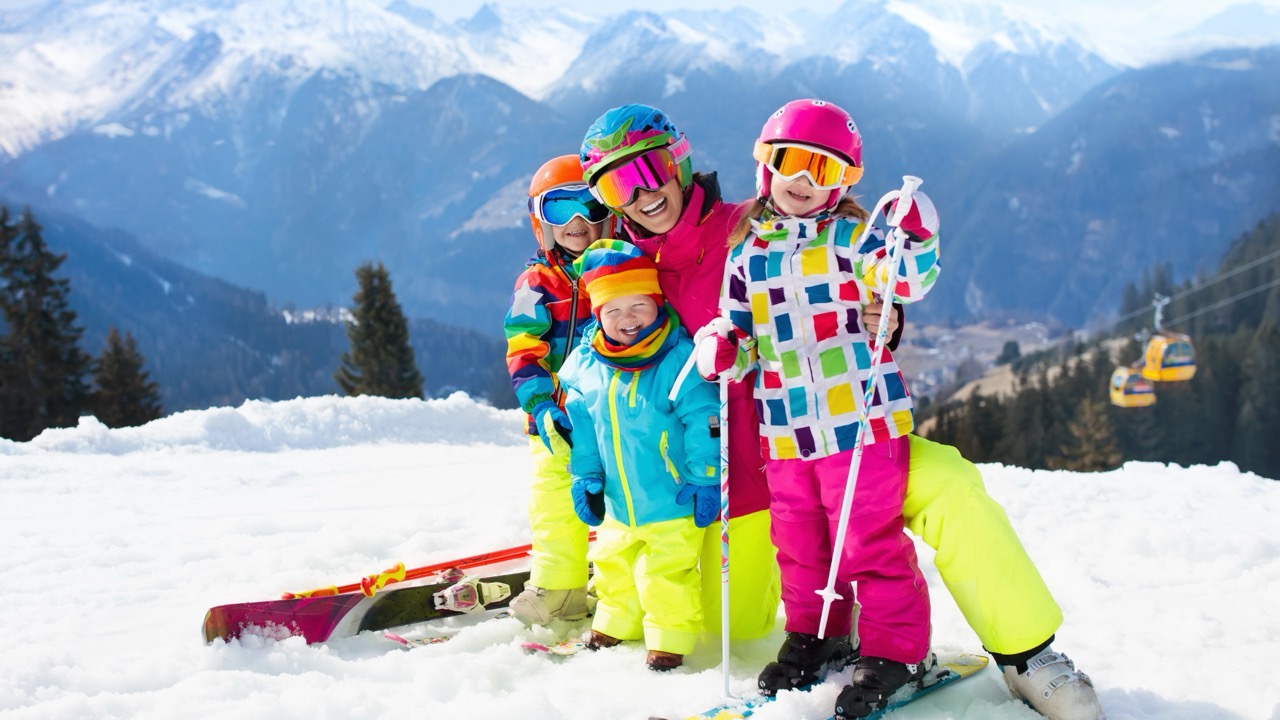
This is a guest post submitted by Elizabeth Bauer from Kindred Courage
Elizabeth from Kindred Courage, Inspiring Families to Live Adventurously, sat down with Janelle Thomas from Raising Little Rippers to learn how families can have successful and safe days on the mountain.
- Related: Top 10 Tips for Skiing With Kids
Elizabeth: Hi Janelle! I have been following you for years and love your passion for empowering families to ski and snowboard together. Please introduce yourself.
Janelle: I am Janelle Thomas, a full-time ski instructor and full-time mom of three. I started Raising Little Rippers in 2016. After teaching skiing for about 20 years, I thought, what can I do with the knowledge I have to pass on to families? I decided, why not put it out on the internet? So, I created an educational blog.
Skiing is something the whole family can do from age 2 to 90. It’s an activity that brings us together, gets us outdoors, gets us exercise, keeps us healthy, is good for our mental state, and bonds us. Skiing and riding is something I’d like to share with everyone.
E: Can you tell us parents’ most significant challenges on the mountain when skiing or snowboarding with their kids? And what do you recommend to increase the likelihood of happy days?
J: My best advice for families with younger children, especially if they’re just getting started, is to be patient and have realistic expectations. We’re introducing kids to these sports at younger and younger ages, and you can’t jump right into it. It’s baby steps. Consistency is key. Being able to go day after day after day, even if you’re only out there with the kids for an hour or two, just be consistent; their skills will improve so fast. But that being said, you can ski very little each season. As long as it’s each season, the skills will still grow and develop.
We need to give kids more credit. They progress so much faster than adults. It’s one of the reasons I always enjoyed teaching children. They’re so much fun. So, consistency and patience are the two essential skills parents need for great days on the mountain. And on top of that, you have to keep it fun. I started introducing my kids as soon as they could walk, but we were only doing 30 minutes on the hill. This was a partial-day event. It was a full-day event just getting the gear in the car, getting to the mountain, getting in the lodge, getting on the hill, then 30 minutes of ski time, and we’re back in for a snack. So, have a positive attitude and look at your day as an opportunity to have fun with your kids instead of, I’m going to go ski x number of runs today, or we’re going to ski fresh powder all afternoon. Having realistic expectations keeps it fun for everyone.
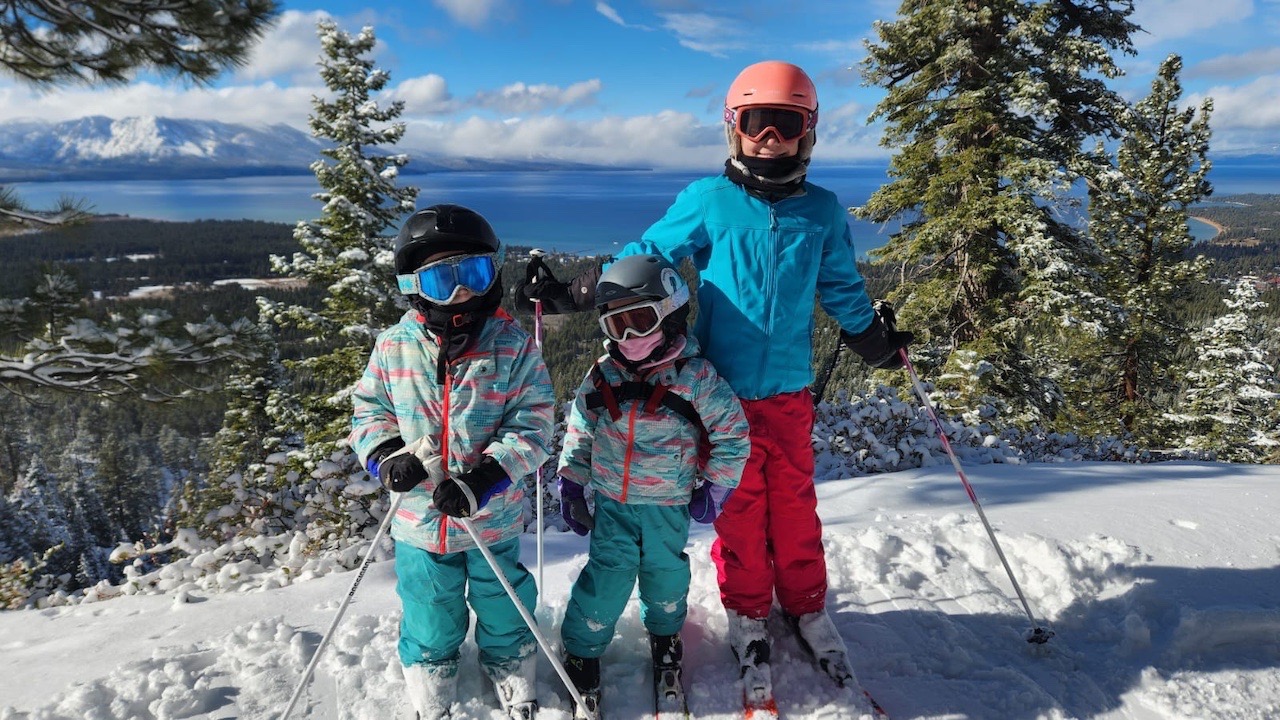
E: For families whose children have yet to begin, maybe this is their first season; what do you recommend to get them started?
J: I always recommend introducing kids to their equipment at home. A lot of gear goes along with this activity, even just getting comfortable wearing a helmet, wearing goggles, understanding how to work the layers, and making sure there’s no ski sock bunched up in the ski boot. When we’re trying to get our kids dressed and ready in all this new gear, either out of the back of the car or in the lodge, next thing you know, your kids are overheating and parents are getting frustrated. Introducing kids to all the equipment, the clothing, the skis, and the boots at home is a good idea. As a parent, you may be accustomed to the gear and the environment, but you forget that this is a lot for a kid. Your child has a lot of gear on; they are in stiff boots and on skis. It might be windy, and it’s probably cold. You throw all that into the mix, and you take a child who might be anxious or have some fear, and you’re just setting them up for a disaster. So, I like to set kids up for success.
Once you get on the hill, I recommend families start on the flats. I know it’s tempting to head right up a lift or hit the magic carpet, but there are a lot of really great skills that can be learned on the flats.Skills like slipping and sliding across the hill, rolling from one edge to another, practicing the duck walk, practicing the sidestep, and learning how to use those skis as if they were our feet. Oh, and snowboarding. I generally talk about skiing, but I do snowboard, so I hate to leave out the snowboarders. Still, especially with skis, starting on the flat is important. Depending on where you live, you can do that in the front or backyard. I’ve taken young children who didn’t have a pass to the base of a trailhead where we just hiked up a little bit but primarily, we were practicing all of our flat land skills.
E: That’s perfect. That allows for practice without the financial investment. For families, there’s the pressure of the money they spend on a ski vacation, which makes everything feel more stressful. Skiing is so expensive these days.
J: That’s another thing to consider. Luckily, If you’ve purchased an adult ticket, many resorts offer a free ticket for kids under 5 or 6. If you’re lucky and have a season pass, that’s a huge bonus. But if you don’t, I recommend finding a resort with a great beginner area and a magic carpet. You can often buy a ticket for just the beginner hill or the magic carpet, and it’s relatively inexpensive. Then you don’t have that stress of, “Man, I bought this ticket, and I’m not going to make it to the summit today.”
E: What advice do you have for parents who love to ski and snowboard and want to share the sport with their child, but the child isn’t loving it? Skiing/Snowboarding is a value in their family, and they will keep doing it. Do you have any tips for families to help their children have a better time out there?
J: It would be best to remember that children change, so offer some grace and give them time to evolve. I think it’s easy for parents to get extra worried. Like, “This can’t happen. I need to have a family that wants to go skiing.” So we pressure our children, and pressure never works. No one wants to be pressured into doing anything. So remember that maybe the child is going through a phase. Embrace and love them for it and try to dig into what’s happening because skiing is fun! If a child isn’t having fun, there’s got to be a good reason. It could be a variety of things, and depending on a child’s age, it can be challenging for a child to understand why they are resistant to skiing or snowboarding. My middle child has very high anxiety, and so had a few years where I wondered if he would keep skiing. He was getting old enough that we could leave him at home, but I didn’t want to encourage that. I wanted to help him move through his anxiety. There was a lot of conversation with him the night before about what he was feeling anxious about.
I found that even if we’d had conversations and he felt ready to have a good time, things could trigger him when we would get to the mountain. It could be something as simple as a tag bugging him, putting on all the gear, or something not fitting quite right. The next thing you know, he’s sweating bullets, pulling off his gear, and not ready to ski. Those were challenging years, and we had to slow down. We decided that the best option was to make sure he had a choice. So even though we didn’t leave him at home, if he needed to stay in the lodge and take a break, he was old enough to do that. If he decided he was done before we were, he was old enough to do that. I give all kids, at all ages, a choice, even the little ones. It’s essential to tune in to what’s happening with them and where they are. Are they comfortable? Are they cold? Are they hungry? Are they tired? Maybe they are afraid, and nobody’s taking the time to acknowledge their feelings. Young kids sometimes have difficulty sharing that information, so choices are important. Remember that they’re human beings and may need to share something before skiing can be a positive experience for them.
E: Last year, when we spent a week skiing in France, our 3-year-old wouldn’t let go of my husband’s legs. Not once. It took so much patience to say to ourselves, “It’s okay; this is what skiing is for him this season. It’s okay.” We’ll be in Lake Tahoe this season, and I’ve already got the nerves thinking, “Oh my gosh, what if our four-year-old won’t let go of Daddy’s legs again?
J: You guys may get out there, and he won’t even remember last year, or he might hop right back into that position. If he does, I encourage you to give him something to hold on to, but extended away from Dad’s body, like a ski pole or a hula hoop. A hula hoop is a fun one because you can put it around his waist so he can hold the edge, and then Dad can have it from behind. Anything you can use to help him move away from physically holding on to Dad, you know, being a little more independent and on his own, but still feeling secure.
E: That’s such good advice. Speaking of ski poles, that’s a big conversation in our family. When is a child ready for ski poles?
J; I love this question. I recommend using ski poles once your skier can control their speed by using their turns, not just a wedge. A wedge is a great skill. But eventually, they have to move out of that to progress onto steeper runs where they can stay in control. If a child can ski in control and use turns to control their speed, they’re probably ready to introduce a ski pole. However, there’s a final factor, where’s their desire? If your child is super excited, go for it. If your child wants nothing to do with them, don’t push it. It’s an optional skill, and many people will push ski poles on their kids too soon.
Sometimes, kids tend to become dependent on poles in ways that are not productive. For example, sticking them in the snow to try to slow themselves down. In the beginning, they’re generally not using them for rhythm. They’re not skiing double black diamonds or moguls and trying to use them for technique. So it’s a matter of whether or not they’re ready to have that extra piece of equipment on their body. It’s very child-dependent, but the skill you’re looking for is whether or not they can control their speed with their turns versus a wedge.
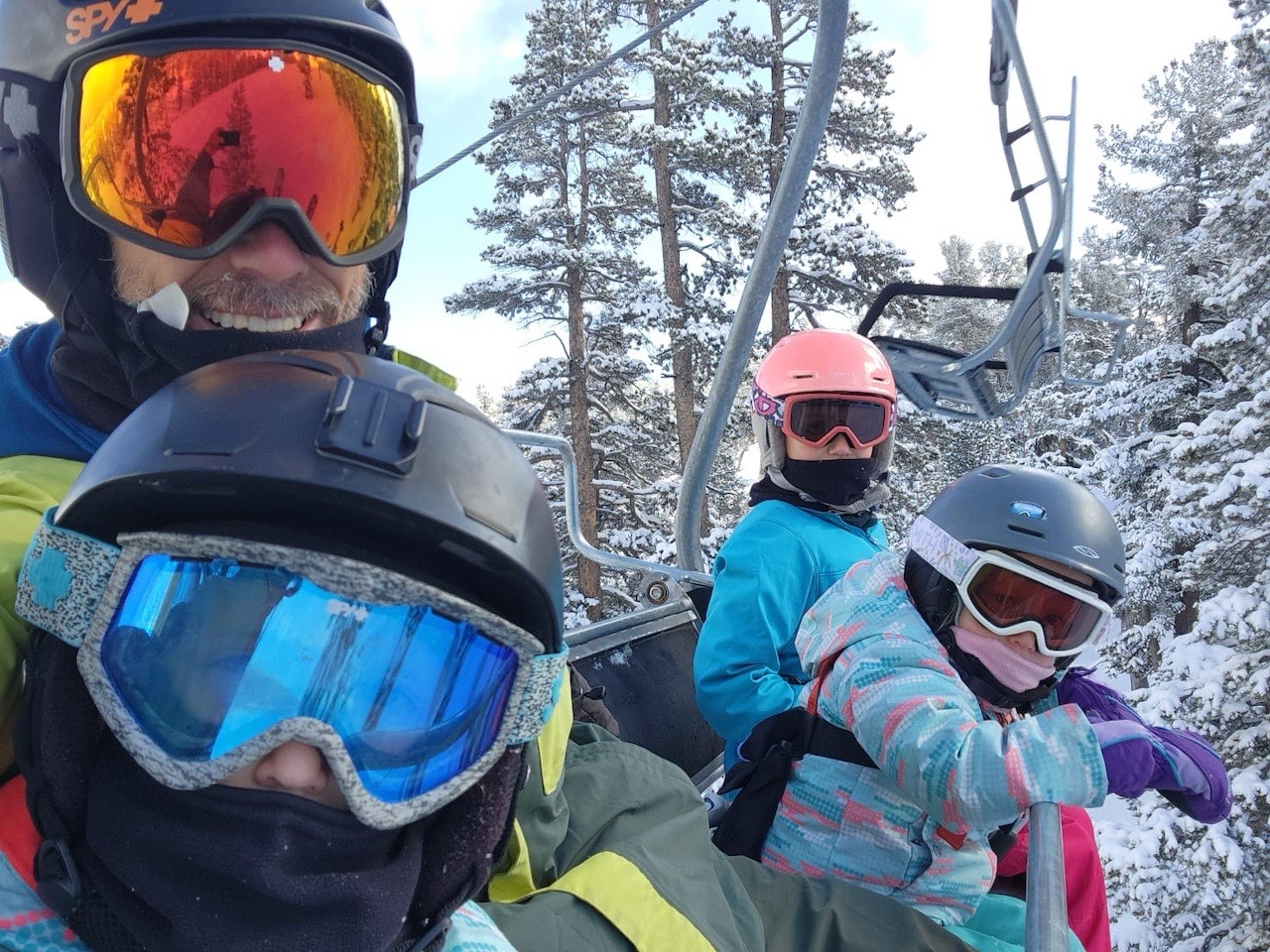
E: Okay, next question: Here’s a big one, Ski School or parent as a teacher. What do you think?
I think you are your child’s best ski instructor. I meet many parents who feel their child is at a loss if they aren’t in ski lessons. However, when introducing a child to skiing, one-on-one attention with a parent who knows them, their personality, and how to get them excited is great! A parent has so many skills they bring to the table that can make the introduction to skiing much more fun.
There are many reasons to pop a child into a lesson. Lessons are a blast for very social kids, kids who like to ride with other kids. Kids like my youngest, who is a visual learner. He learns best by following someone who challenges him. Or let’s say you’re on a ski vacation, and parents want to take an hour or two to themselves. This is an excellent opportunity to throw your children in a ski lesson. They will meet some other kids, learn a few skills from the instructor, and then go back out with you in the afternoon. Most of the kids that are in my lessons are having fun. But, when it comes down to it, they can’t wait to get back on the hill with Mom and Dad. So that’s another reason to teach your children because it’s about spending time together as a family. Ski lessons can be a waste of money initially. It can also be very stressful for a child who has fear or anxiety. Parents need to remember that even if you are just a beginner skier yourself if you’re capable of skiing the beginner hill, you have enough skills to introduce your children to skiing.
Remember that in a lesson, it takes a good 30 minutes to 45 minutes for the instructor to evaluate and get to know each student, and that’s a lot of wasted time. By the time the lesson is over, the instructor is just getting to know your child. Then they ship them off to you, and you take them out skiing anyway. Let go of the fear or concern that your child will not learn or progress as quickly if they learn with you.
E: Any other thoughts about the parent/child relationship and learning to ski/snowboard?
J: I started skiing when I was four, so when I became an instructor, I didn’t understand what it was like to be a beginner. For me, skiing was like walking. So I decided to pick up a snowboard, and that was one of the best things I ever did because skiing and snowboarding are so different. The only thing they have in common is that they both slide down the ski hill on snow. They’re two very different sports. Learning to snowboard put me back in the position of being a beginner, looking down at a beginner run and feeling intimidated.
If you’re a parent who’s been skiing or snowboarding for a long time, it’s not a bad idea to switch it up and try something new. Learn right alongside your kids! I love the idea of your child seeing you challenge yourself to try something new. Our kids look up to us so much. To them, we’ve always been good at everything. And you know, that’s just not realistic.
It’s one of the things I love about skiing. It teaches great life skills. It’s good for the mood, the mind, and the body. If nothing else, it’s perfect for bonding relationships.
E: What if a parent doesn’t know how to ski? They may have recently moved to an area where skiing is available or they want to become a skiing family. Still, they’re uncomfortable on skis and feel intimidated because they want to ski with their child only if they know what they’re doing.
J: I’ve met parents who want their kids to learn to ski, so they sign their children up for lessons and sit in the lodge. I think, “No, no, no, no!” There are a lot of ski schools that will do family lessons. So there’s an opportunity to take a lesson with your children. You can find an instructor that will go out with just your family. It would be more expensive. It’d be a private lesson, but they will teach you and your family. The great thing about this option is if you have a good instructor, not only are they going to teach all of you (according to your age and ability), but they’re also going to give you, as a parent, some tips for when you’re no longer in the lesson.
The biggest trick with learning together is managing the chairlift. As parents, we are trying to figure it out independently and also want to assist our children. So that can be the trickiest part. Again, I recommend the magic carpets; if you have a ski resort with a magic carpet, those have been some of the best learning tools added to the ski school. And most ski resorts have those open to the public, not just the ski school.
E: For kids who are already proficient skiers, what skills and safety knowledge does a child need to be able to go off on the mountain by themselves?
J: That’s a big one. So that’s really where my focus is right now. I’ve spent several years helping parents support their child’s skiing progression and skills. Still, the conversation often leads to safety and risk management. I’m creating an app that will be filled with fun, gamified micro lessons about instilling risk management into our young riders.
Risk is valuable and managing risk is a skill that kids will take off the mountain and into real life. Being able to approach a risky environment confidently gives you the best chance of riding another day. This knowledge is invaluable. I’m excited to work on this new program because there is a gap between what we expect people to know and what they actually know. Mountains are getting busier and busier, and we’re introducing kids to these sports at a younger and younger ages. We’ve got two, three, four, and five-year-olds skiing black diamonds. They’re skiing around tree wells that could swallow them whole. As parents were there with them and we’re helping them manage those risks, but we’re not doing them any favors if we’re not introducing them to risk-management skills, even at a very young age, I’m big on acknowledging that even two-year-olds can begin to learn risk management skills. When my children were getting to the age of wanting to ski without us, when they were asking to take some runs by themselves, I asked myself the same questions: are you old enough? Is this legal?
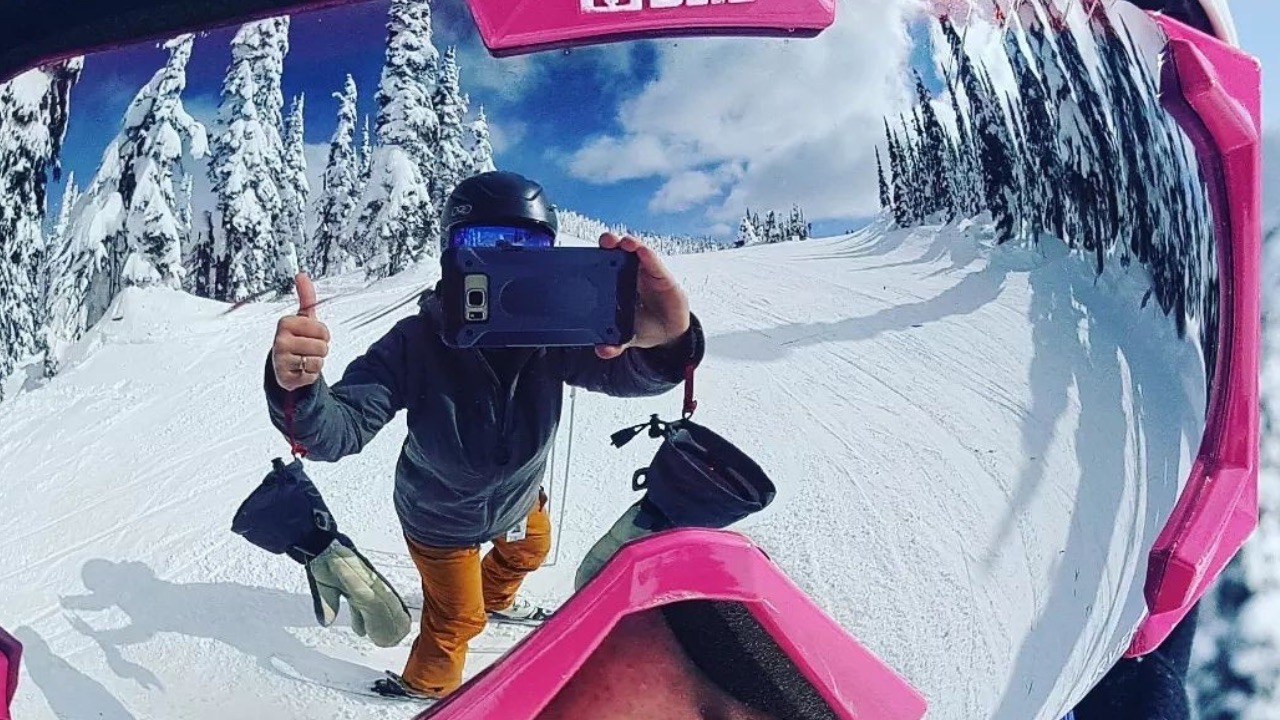
E: Haha. Yeah, right.
J: The way we stand right now as a family is that you always ski with a buddy. We don’t go anywhere alone. I’ve been on runs on my own, on incredibly great powder days, and everyone in my family was elsewhere. I wanted so badly to go off-piste, and I had to remind myself it was not worth it. We’re at Whitefish Mountain Resort, and in the last several years, I believe four people have passed in tree wells. Even expert skiers end up in tree wells. If no one is there to help you, you’re out of luck. 90% of people in a tree well could not rescue themselves. Your chances are slim to self-rescue.
E: Okay, so skiing with a buddy is a huge safety tip.
J: Number one.
E: Number one. Any other specific skills you want to see in your child and maybe their sibling or a friend before you’re ready to say, okay, you guys can go off by yourself?
J: I want to know that they know the terrain. Whether they’re familiar with that terrain because they’ve skied it before, or if we’re in a new area, then we take the time to go over a trail map. We will plan out where they’re going to go, and where they will end up. Another specific skill I want a child to have is to be able to sideslip. If someone gets into sketchy terrain and needs to get out, the sideslip will do that for them. I do not recommend taking off skis and trying to walk down the hill. Once you start slipping and sliding, you could end up at the bottom. Another thing, I ensure before children ski off together, is that they have my contact information and the ski patrol’s information. Two of my kids have cell phones. One does not. So, he carries that information in a pocket. If your child has a cell phone, I recommend pre-programming the ski patrol number into the phone.
Kids must understand that there isn’t always a signal on the mountain. I don’t rely on a cell phone in the mountains because they’re unpredictable. I wish a company would come out with a better communication product for the mountains. There’s a few that I think have potential. There’s one called Bb Talkin’, and then another called Milo Action Communicator. That one looks really interesting because it’s hands-free. It’s a communicator that hangs on you, and you can talk back and forth. I love the idea of these devices for skiing down the hill as a family. We’ve gotten to a point where we’re constantly yelling at each other. We ski and ride about the same ability, but you get to a point in your skiing where you want to ski and get a flow going. It’s frustrating to stop that flow because someone’s yelling at you and trying to get your attention. And yelling at each other is risky because when you can’t communicate properly, it causes people to stop in places they wouldn’t usually stop or turn in ways they wouldn’t normally turn. But yeah, make sure that your child has the contact information they need for ski patrol and also for you in case somebody needs to reach out and find you to assist them.
E: So where can people find you to follow along and learn more?
J: One of the best places to find information is on my website, www.raisinglittlerippers.com. I highly recommend you join my newsletter. It is seasonal. I only send information that is relevant and helpful. I put a lot of free coaching in my newsletter and share gear reviews and the good deals I come across. We’ve always lived on a very tight budget, and I know that skiing is a privilege for us. So, I’ve gotten good at figuring out how to do it on a dime. I am also on Instagram. We have a great little community on Instagram that is growing every season. My goal is to connect families and feature families so no one feels alone.
E: And what about your App? When can we expect it to launch?
J: I plan on launching it next season. My app will be a resource that families can access at resorts nationwide. Ski instructors will also be able to share it with parents who have questions like, how do I get my child on and off the lift? This information is necessary but isn’t readily available. The app will be something you can access on your phone offline.
E: Thank you so much for taking the time to share your wisdom and experience. I’ve found so much value in this and am excited to get my kids on the mountain.
J: You’ll have so much fun, and I’ll do my snow dance! Hopefully, it’ll be coming your way.
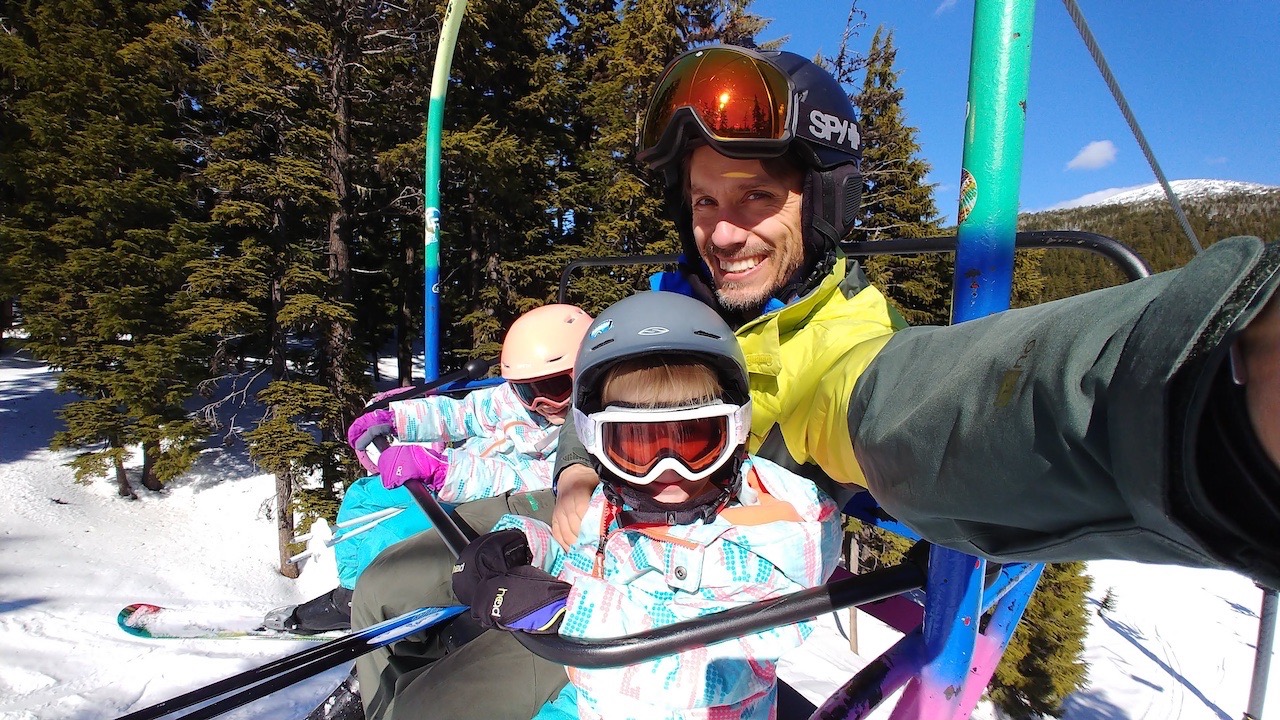
She lost me on the parent as a teacher thing. Maybe, she, as a longtime professional ski teacher, can mitigate the tricky dynamic of a loved one teaching an athletic skill. While it can work w/ motivated parents blessed w/ plenty of time and patience, I’ve witnessed too many disasters when parents are involved in the early process, and it wasn’t pretty. It also discounts the many learn to ski programs for young children w/ expert instructors that have the skills and temperament to effectively teach young children in a fun and friendly atmosphere. As always, there are exceptions and YMMV.